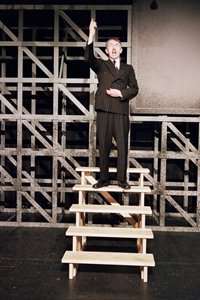In times of national economic crisis, sometimes it appears that the best option is to support powerful individuals in a blinkered fashion, placing our faith in them to get us out of this mess, despite our knowledge of their past corruptions and their tendencies to create ‘jobs for the boys’. Such is the theme of Bertolt Brecht’s The Resistible Rise of Arturo Ui, a parody of Hitler’s rise to power but set in a gangster-ridden Chicago rife with warring factions in the cauliflower trade and political corruption at the highest level. Its relevance to contemporary culture of economic recession is self-evident.
Under Lisa May’s direction, early in the production, each actor takes it in turn to stand on the rostrum as his or her name appears on a large video screen located onstage, and as the performance progresses, Bruiser Theatre Company take every opportunity to remind us of Brecht’s ‘verfremdungseffekt’, a ‘making strange’ and a highlighting of the fact that this is a performance piece. Rather than encouraging the spectator to become emotionally engaged with the characters, Bruiser’s production asks the audience to reflect on the larger societal and political questions raised by the narrative.
Throughout the first half of the performance, the ensemble cast have a marvellous energy, their stylised movements and use of tableaux obviously well-rehearsed and timed to perfection, with notable performances from Damien Hasson and Charlie Murphy in particular. The actors move seamlessly around the various levels of David Craig’s wonderfully sparse set, beating out rhythms, making their own sound effects, and singing unaccompanied. However, while the high energy levels of the ensemble cast may be an attempt to engage the audience, the sheer amount of tableaux and stylised movements tend to distract from rather than add to Brecht’s words. The production is actually at its best when it simply allows Brecht’s text to speak for itself, such as during the private exchange between Arturo (Jack Walsh) and Dogsborough (Charlie Murphy).
Similarly, in the press scenes and scenes featuring the vegetable dealers, the cast work well together, creating a sense of the number of reporters present and the extent of the crowd gathered. Holding poles with peaked caps sitting on top, the actors generate new characters with their props, an approach which results in much humour. However, this technique is also over-used and the sniggering and muttered comments in the crowd scenes become distracting. Such distraction is also evident in many scenes featuring Arturo and his mob, the reactions and background utterances from minor characters risks upstaging the main action.
As the story of Arturo is played out it becomes obvious that the production is heavily influenced by film noir and gangster films of the 1930s and 1940s. Sean Paul O’Rawe’s dark and moody lighting serves to enhance such an approach while a video screen is used at various moments to represent shooting and bullet wounds and show silhouettes of gangsters. May’s approach to such themes has both advantages and flaws. The gangster hats worn by the actors often make it difficult  to see their faces, and the comic nasal accents reminiscent of mobster films begin to grate upon the ear.
to see their faces, and the comic nasal accents reminiscent of mobster films begin to grate upon the ear.
As Arturo continues on his rise to power, his past deeds begin to haunt him and this is splendidly represented on stage. As Roma (Tony Devlin) haunts his dreams while Arturo lies in Hotel Mammoth, a series of hands emerge from under the sheets, chillingly clinging to his chest and then threatening to choke him. Despite such engaging moments in the second half, however, coming after a first section high in energy, the pace of the latter part is very slow. Arturo’s rise to power is not portrayed in a dramatic fashion. When an actor, excellently played by Damien Hasson, is hired to teach Arturo how to walk and speak, Arturo’s physicality and speech do not change in anyway. While Lisa May’s direction may be partly responsible for this limited representation of character trajectory, Jack Walsh does not appear comfortable in his role and is often unsure of his lines.
Despite these failings, Bruiser Theatre Company has put together an interesting and ambitious production that provokes questions about current economic conditions and the politicians we hope will remedy the situation.
Pádraic Whyte is a Visiting Research Fellow at the Institute of Irish Studies, Queen’s University Belfast.